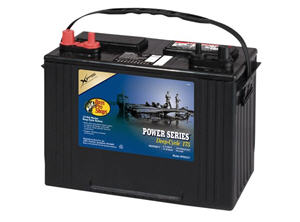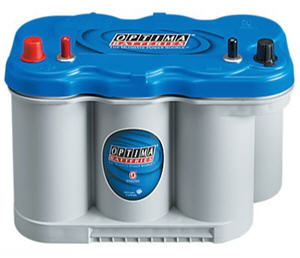
Selecting a new 12-volt marine battery for your boat can be a daunting task for first-time buyers. You may be asking questions like "What type of battery is used for a trolling motor"? or, What is a deep cycle battery"?. Many types are available, each with a different purpose, and each with various advantages and disadvantages. With this handy buyer's guide, however, you'll have easily understandable information at your fingertips so you can choose a battery ideal for the tasks at hand.
 |
| Understanding the different types of marine boat batteries available and their applications will help you select the right one to power your rig. |
Basic Boat Battery Types
There are two basic types of 12-volt batteries: 1) cranking, or starting, batteries, which are designed to start your main engine, and 2) deep-cycle batteries, which are used to power electrical accessories such as trolling motors, fish-finders and radios. Dual-purpose batteries that can perform both these functions to some extent also are available.
1. Cranking Boat Batteries
Engine cranking requires lots of power in a short burst. A battery with more surface area on the lead plates inside it delivers more fast power than one with less plate surface. For this reason, cranking batteries are made with thinner, more numerous lead plates. When the engine is running, the battery is quickly replenished by the alternator.
The marine cranking amp (MCA), or just cranking amp (CA), rating found on a battery's label measures a battery's starting power. And if you're using a newer model outboard with sophisticated computers, pumps and sensors that don't take kindly to being underpowered, you certainly don't want to scrimp on starting power. Check your engine's manual for its recommended MCA/CA rating before shopping for a battery, and always choose a battery with a rating equal to or greater than the recommended value.
2. Deep-Cycle Boat Batteries
Trolling motors and other accessories sip power at a slower rate for extended periods. Batteries that power them usually aren't recharged until the end of the day. These deep discharges are hard on battery plates, so a deep-cycle battery like the Bass Pro Shops XPS 12-Volt Deep Cycle Marine Battery have fewer yet thicker lead plates than cranking batteries and are built to withstand deep cycling.
A deep-cycle battery's reserve capacity (RC) rating indicates how long it can carry a specific load before falling into the dead zone. The higher the RC number, the longer the battery will power your accessories. Remember this when choosing a battery. Typically, a deep-cycle battery will have two or three times the RC of a cranking battery. A deep-cycle battery also can withstand several hundred discharge/recharge cycles, while a cranking battery is not designed to be totally discharged.
![]() No Substitutions: The key thing to remember when purchasing cranking and deep-cycle battery types is not to substitute one for the other. If you use a cranking battery to power your trolling motor, for instance, the battery will soon overheat and fail, leaving you without power and requiring you to buy a new battery. A deep-cycle battery substituted for a cranking battery, on the other hand, may not provide the power needed to start your outboard. You could get stranded with an engine that won't run. The inherent design strengths of each battery type also are their weaknesses in opposite applications.
No Substitutions: The key thing to remember when purchasing cranking and deep-cycle battery types is not to substitute one for the other. If you use a cranking battery to power your trolling motor, for instance, the battery will soon overheat and fail, leaving you without power and requiring you to buy a new battery. A deep-cycle battery substituted for a cranking battery, on the other hand, may not provide the power needed to start your outboard. You could get stranded with an engine that won't run. The inherent design strengths of each battery type also are their weaknesses in opposite applications.
![]() Extra Tip: About Marine & Boat Battery Maintenance
Extra Tip: About Marine & Boat Battery Maintenance
3. Dual-Purpose Batteries
 |
| Bass Pro Shops® XPS® Pro Qualifier® AGM Dual-Purpose 120 Marine Battery delivers up to 775 cold cranking amps for engine starting, plus full deep-cycle performance for running a trolling motor and accessories. |
It's usually best to install separate cranking and deep-cycle batteries. If your boat is small, however, and there's only room for one battery due to space or weight restrictions, consider buying a dual-purpose marine battery that handles starting and cycling. Bear in mind, however, most dual-purpose batteries won't start an engine quite as well as a true cranking battery and won't endure as many deep discharge/recharge cycles as a dedicated deep-cycle model.
4. Wet Cell, Gel or AGM Boat Battery?
Batteries can be further categorized as wet cell, gel or AGM (absorbed glass mat), depending on the configuration of the electrolyte, or conducting medium, inside the battery. Each type has pros and cons you should know before making a purchase.
![]() About Wet-Cell Boat Batteries: The traditional lead-acid batteries we all are familiar with are wet-cell or "flooded-cell" batteries. Each wet-cell battery contains a liquid mixture of sulfuric acid and distilled water (usually referred to as "battery acid"). This is the most popular battery type, primarily because the price is generally less than other types, but also because these batteries have a number of inherent advantages. For example, a properly charged and maintained, premium wet-cell battery is capable of as many as 1,000 discharge/recharge cycles. This can translate to many years of dependable service at an initial cost substantially less than comparable capacity gel or AGM batteries. Wet-cell batteries also are less likely to be damaged by overcharging and tend to weigh less than comparable gel or AGM batteries.
About Wet-Cell Boat Batteries: The traditional lead-acid batteries we all are familiar with are wet-cell or "flooded-cell" batteries. Each wet-cell battery contains a liquid mixture of sulfuric acid and distilled water (usually referred to as "battery acid"). This is the most popular battery type, primarily because the price is generally less than other types, but also because these batteries have a number of inherent advantages. For example, a properly charged and maintained, premium wet-cell battery is capable of as many as 1,000 discharge/recharge cycles. This can translate to many years of dependable service at an initial cost substantially less than comparable capacity gel or AGM batteries. Wet-cell batteries also are less likely to be damaged by overcharging and tend to weigh less than comparable gel or AGM batteries.
One disadvantage of wet-cell batteries is the fact that most have vented, interior accessible designs. This requires they be regularly inspected and the cells topped off with distilled water. Venting also releases hydrogen gas, which means the battery compartment must be well ventilated. Other drawbacks include possible spilling of corrosive battery acid, a higher rate of self-discharge (6% to 7% per month) and the fact that wet-cell batteries are more fragile in high-vibration environments such as boats.
![]() About AGM Boat Batteries: AGM batteries feature a dense filling of absorbent glass matting packed tightly between the battery's plates. The matting is saturated with acid electrolyte. This allows oxygen to recombine with hydrogen gas to replenish the battery's water content and alleviate the need for refilling. No maintenance is required, except periodic external cleaning. And because these batteries are sealed, acid inside cannot spill and flammable gases aren't released. AGM batteries also can be installed at any angle. They are shock and vibration resistant, submersible without damage unlike wet-cell batteries, and have a low self-discharge rate (around 3% per month at 77 degrees F). Primarily drawbacks are higher initial cost, greater weight than comparable wet-cell batteries and the fact water cannot be replaced if the battery is accidentally overcharged.
About AGM Boat Batteries: AGM batteries feature a dense filling of absorbent glass matting packed tightly between the battery's plates. The matting is saturated with acid electrolyte. This allows oxygen to recombine with hydrogen gas to replenish the battery's water content and alleviate the need for refilling. No maintenance is required, except periodic external cleaning. And because these batteries are sealed, acid inside cannot spill and flammable gases aren't released. AGM batteries also can be installed at any angle. They are shock and vibration resistant, submersible without damage unlike wet-cell batteries, and have a low self-discharge rate (around 3% per month at 77 degrees F). Primarily drawbacks are higher initial cost, greater weight than comparable wet-cell batteries and the fact water cannot be replaced if the battery is accidentally overcharged.
 |
| The Optima® Blue Top Marine Battery is maintenance-free and completely spillproof. |
![]() About Gel Boat Batteries: Gel batteries are filled with liquid electrolyte that is gelled with silicates before the battery is sealed. Like AGM batteries, they use recombinant technology that eliminates the need for adding water. They are maintenance free, sealed, low-temperature tolerant, shock/vibration resistant and have long cycle life. Their most notable advantage is resistance to over-discharge that can damage other battery types. Gels have an internal self-discharge rate less than 1 percent per month, so they can be stored for long periods without being recharged. And because they aren't prone to develop life-shortening plate sulfation when left uncharged, they are a good choice for boaters who often forget to recharge batteries promptly after use.
About Gel Boat Batteries: Gel batteries are filled with liquid electrolyte that is gelled with silicates before the battery is sealed. Like AGM batteries, they use recombinant technology that eliminates the need for adding water. They are maintenance free, sealed, low-temperature tolerant, shock/vibration resistant and have long cycle life. Their most notable advantage is resistance to over-discharge that can damage other battery types. Gels have an internal self-discharge rate less than 1 percent per month, so they can be stored for long periods without being recharged. And because they aren't prone to develop life-shortening plate sulfation when left uncharged, they are a good choice for boaters who often forget to recharge batteries promptly after use.
Gel batteries show their dark side when it comes to price and recharging. They generally cost more than other battery types with the same RC and MCA ratings. Most manufacturers recommend charging them to at least 13.8 volts, but no more than 14.1 volts. Standard marine battery chargers routinely reach higher voltages, so chargers designed to include gel batteries or those with a gel setting must be used.
![]() Extra Tip: 3 Awesome Battery Chargers for Your Boat
Extra Tip: 3 Awesome Battery Chargers for Your Boat
In Conclusion
Understanding the differences between the various types of batteries, and the pros and cons of each, should no doubt prove useful when you're trying to decide which battery will work best to crank your boat and power all your accessories. Making the right choice eliminates many worries when you are on the water, allowing you to concentrate on the most important reason you bought your boat in the first place -- having fun.
- 232458 views

